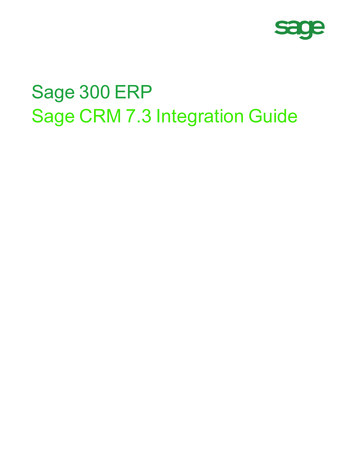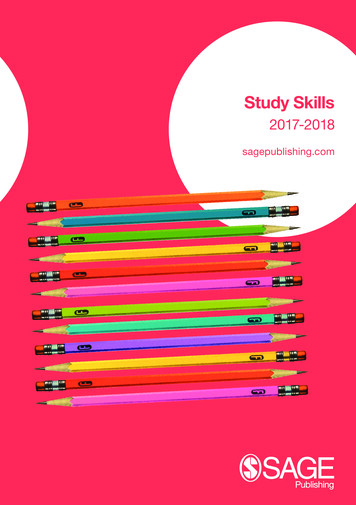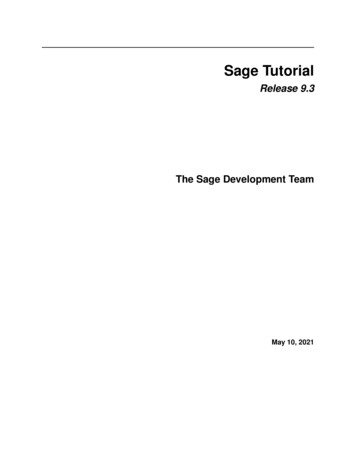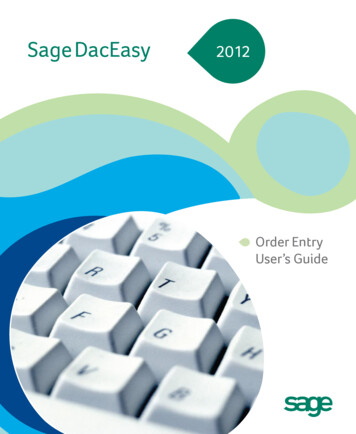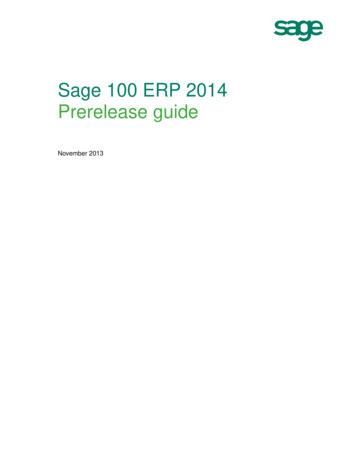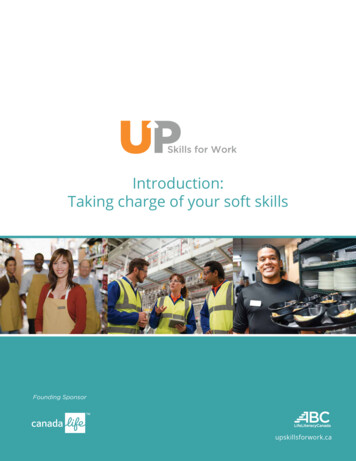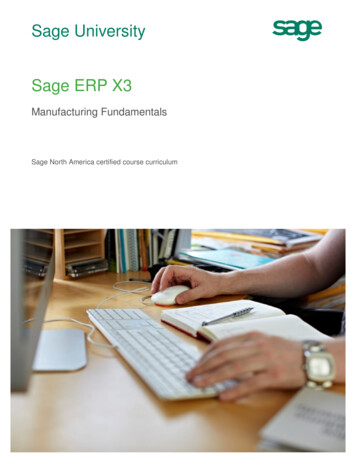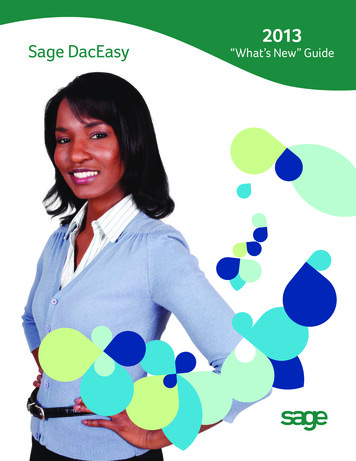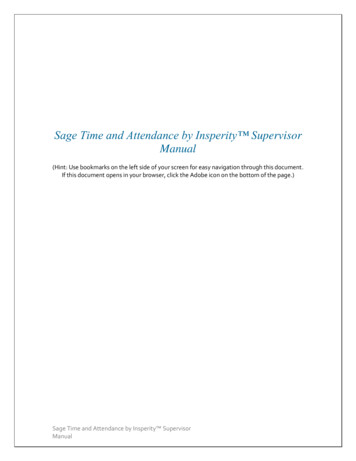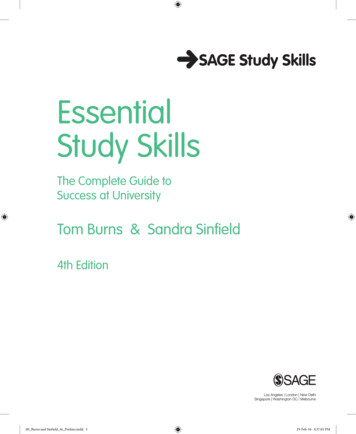
Transcription
EssentialStudy SkillsThe Complete Guide toSuccess at UniversityTom Burns & Sandra Sinfield4th Edition00 Burns and Sinfield 4e Prelims.indd 319-Feb-16 4:37:03 PM
SAGE Publications Ltd1 Oliver’s Yard55 City RoadLondon EC1Y 1SPSAGE Publications Inc.2455 Teller RoadThousand Oaks, California 91320SAGE Publications India Pvt LtdB 1/I 1 Mohan Cooperative Industrial AreaMathura RoadNew Delhi 110 044SAGE Publications Asia-Pacific Pte Ltd3 Church Street#10-04 Samsung HubSingapore 049483Editor: Marianne LagrangeEditorial assistant: Robert PattersonProduction editor: Tom BedfordCopyeditor: Gemma MarrenProofreader: Andy BaxterMarketing manager: Catherine SlinnCover design: Stephanie GuyazTypeset by: C&M Digitals (P) Ltd, Chennai, IndiaPrinted and bound in Great Britain by Bell andBain Ltd, Glasgow Tom Burns and Sandra Sinfield 2016First edition published 2002Second edition published 2008Third edition published 2012This fourth edition published 2016Apart from any fair dealing for the purposes of research orprivate study, or criticism or review, as permitted under theCopyright, Designs and Patents Act, 1988, this publicationmay be reproduced, stored or transmitted in any form, or byany means, only with the prior permission in writing of thepublishers, or in the case of reprographic reproduction, inaccordance with the terms of licences issued by the CopyrightLicensing Agency. Enquiries concerning reproduction outsidethose terms should be sent to the publishers.This book may contain links to both internal and externalwebsites. All links included were active at the time the bookwas published. SAGE does not operate these externalwebsites and does not necessarily endorse the viewsexpressed within them. SAGE cannot take responsibility forthe changing content or nature of linked sites, as these sitesare outside of our control and subject to change without ourknowledge. If you do find an inactive link to an externalwebsite, please try to locate that website by using a searchengine. SAGE will endeavour to update inactive or brokenlinks when possible.Library of Congress Control Number: 2015949706British Library Cataloguing in Publication dataA catalogue record for this book is available fromthe British LibraryISBN 978-1-4739-1901-3ISBN 978-1-4739-1902-0 (pbk)At SAGE we take sustainability seriously. Most of our products are printed in the UK using FSC papers and boards.When we print overseas we ensure sustainable papers are used as measured by the PREPS grading system.We undertake an annual audit to monitor our sustainability.00 Burns and Sinfield 4e Prelims.indd 419-Feb-16 4:37:04 PM
2How to Learn,How to StudyWe’re not born knowing how to study – these learning and studying strategies will helpyou make the most of the study aspects of university. Introduction Past learning experiences What is learning? Harness a multi-sensory approach to learning Studying: when, where and how Independent learning A beginner’s guide to taking control of your studies Summary Further reading Activity: two key things to do right now: learning contract and timetables02 Burns and Sinfield 4e Ch 02.indd 171818192021252629292919-Feb-16 4:25:13 PM
IntroductionIn this chapter we bring together arguments about learning with an exploration ofhow to study – and how to study at university. We begin by asking you to examineyour past learning experiences – and consider a multi-sensory approach to learningand how to harness this. We explore when, where and how to study – with a focuson how universities organise their teaching and learning; assessment is tackled inChapters 11 and 12. As always – think: what do I know? What do I need? Howwill I harness this information to promote my active learning and study success?Past learning experiencesBefore moving on, we’d like you to think back to your own past learning experiences. In particular, think about the conditions that helped you to learn – and thethings that got in the way of your learning. Make brief notes to answer the questionsbelow – then read what another student has said. Think back to a previous successful learning experience. It does not have to have been atschool – it could be learning to drive or sky dive. Why was it successful – why did you learn? Now think back to an unsuccessful learning experience. What was it? Why did little or nolearning take place? Looking over these good and bad experiences of yours – can you sum up: ‘Things that helplearning to happen’ and ‘Things that prevent learning’? If you wish, use your notes to free write quickly on ‘Things that help me learn – and thingsthat stop me from learning’. Once you have completed your own thoughts, compare your thoughts with those written byanother student, below.‘18Things that helped me to learn were an interesting course with a good teacher – youknow, one that has enthusiasm for the subject and lots of energy. I seem to workbetter if I feel that the tutor likes me. It also helps when I actually want to do thecourse; where I have chosen it for myself and I actually want to learn. When I’mcommitted, I turn up and do the work – because I want to. The last course I did, therewas a really supportive atmosphere – I felt challenged and stretched – but it wasalso safe to make mistakes, there were people around to help. Nobody laughed atyou or made you feel a fool.The worst learning experience I had was at school. I had to be there – it wascompulsory – but I never really saw the point of it. I just felt so powerless all thetime. I never knew what we were doing or why or when or how. It was a nightmareand one of the reasons that I left school the minute I could!ESSENTIAL STUDY SKILLS02 Burns and Sinfield 4e Ch 02.indd 18’19-Feb-16 4:25:13 PM
Do you recognise some of yourself in the responses? What might this tell you? Onething we can see is that if we are going to be successful when learning, then wemust want to learn: we must be interested and motivated.On the other hand, what seems to stop people from learning is feeling unmotivated,confused, unhappy, fearful and powerless. These are some of the reasons that compulsory education does not work for some people.TIPWhenever you start to study, sit down and write your own personal goals for thatcourse. Put them on Post-its and display them over your desk. Cut out picturesthat represent your success to you and stick these up also. Use these to keep youmotivated and interested.What is learning?Learning is not about the empty student coming to university to be filled withknowledge and wisdom – though some people might wish that it was! Learningis active and interactive; it is a process. Learning involves engaging with ideas –and engaging with other people as they engage with ideas (Wenger-Trayner,2014). An early author on study skills, Devine (1987), describes learning as aseries of processes: gathering new ideas and informationrecording themorganising themmaking sense of and understanding themremembering themusing them.Learning is about gathering new ideas and information – engaging with and acquiring information from classes, lectures, seminars, tutorials, discussions, practicalactivities, reading (textbooks, journals, newspapers and more). It is notemaking –recording what is important. We encounter information in many forms, in manyplaces and at different times – we have to reorganise the information to makesense of it for ourselves and remember it. Finally we have to be able to use theinformation – we have to be able to discuss it with other people and use it inour assignments. Learning also changes us, once truly learned something cannot beunlearned – we have crossed a threshold and become someone slightly different(Land, 2010).HOW TO LEARN, HOW TO STUDY02 Burns and Sinfield 4e Ch 02.indd 191919-Feb-16 4:25:13 PM
TIPS Before you can forget your lecture or class, don’t rush home, go to the canteen andtalk about it. Get a study partner or form a study group: discuss lectures and seminars. Discussyour reading. Write before you know or understand it all. Discuss your writing.Harness a multi-sensory approach to learningSo learning is active and social and it also involves all the senses. If you went to aMontessori primary school, you would already have been encouraged to see, hear,say and do in order to learn effectively; for we learn some of what we see, we learnsome of what we hear, we learn when we speak or discuss (when we say) and welearn when we do (when we make something or engage in an activity) – but it isargued that we can learn most when we see, hear, say and do. Here we explorevisual (sight based), auditory (sound based) and kinaesthetic (touch, feel or movement based) learning. Sight: to learn by seeing, enjoy learning by reading and by watching television, film or video.Enjoy watching your lecturer and seeing how they convey information – how they show youwhat is important. Use pictures in your learning and revision activities: draw cartoons andpictures to illustrate your points, draw pattern notes, put in colour, and put in memoryjogging cartoon images or visuals. (See also Chapters 5 and 6.) Sound: to learn by hearing and speaking, enjoy learning through listening and joining indiscussions. You will learn as you explain things to other people. Make audiotapes to support your learning using songs, rhymes and jingles that you write yourself as learning andrevision aids. Tape yourself and sing along. Talk yourself through your assignment. Feel: to harness the kinaesthetic, enjoy practical learning activities, from making something,to performing a science experiment to role-playing. Make charts and patterns of the thingsyou want to remember – role-play ideas or act them out in some way. Care about yoursubject – find meaning and value in your course.ActivityWatch, listen, learn: Barbara Oakley has given an interesting TED Talk on ‘How to learn’ (https://youtu.be/O96fE1E-rf8). Watch the video and make notes whilst thinking, ‘How will I use thisinformation to become a better student?’ Reflect: How much of the information did I hear? Howmuch did I see? How much of it did I feel was right?20ESSENTIAL STUDY SKILLS02 Burns and Sinfield 4e Ch 02.indd 2019-Feb-16 4:25:13 PM
‘‘‘Studying: when, where and howI’m a mum, I work, I’ve got my parents to look after I guess I’m organised!’’’Studying is more formalised learning – and it tends to be hard work. We are goingto explore when, where and how to study and provide you with very practicaladvice and tips.When should I study?I know we are supposed to start work weeks before the deadline, but I usually starttwo or three days before.Many students do not start work until a deadline really frightens them – they need thehit of adrenalin to get them over their study fears and into working. The trouble is thatwhilst adrenalin is great for getting you out of a burning building – it does not helpyou develop the depth and breadth you need for university level thinking and writing.The best tip I ever got was to do at least half an hour’s work each day. This has putme on top of all my studies And usually once I start I get a little bit more doneand I feel so much better.I know what I should do, I really know but I just can’t face it.Studying can feel unbearable, un-do-able, like climbing a mountain. But there ismore than one way to face a mountain. For some a mountain is so large and dangerous that they are afraid of it. For some a mountain is an exciting challenge. For somea mountain is just a thing to be tackled sensibly one step at a time. If you normallyfear or dread your assignments – change the way you see them. Adopt a ‘one step ata time’ approach. Look at assignment questions at the beginning of a course. Thinkabout the question before lectures and classes and before you start reading. Breakthe question down into manageable chunks. Read about one ‘chunk’ at a time.Write one paragraph at a time – then revise and improve as you do more reading.‘I never seem to feel like studying.02 Burns and Sinfield 4e Ch 02.indd 21’HOW TO LEARN, HOW TO STUDY2119-Feb-16 4:25:13 PM
Nobody leaps out of bed in the morning going, ‘Wheee – this is the day that Itackle that huge assignment!’ So do not rely on feeling like studying. You haveto make the time to study – you need a system. Every university student has towork out for themselves just how much time they are prepared to give to theirstudies – but it should be 35 hours or more each week. You have to decide howmuch work you are prepared to put in, to get the results – the grades – that youwant. Study five days a week – plan and use your time – even when you don’tfeel like it.When planning out your time think about: Best time of day? Are you a morning, afternoon or evening person? Try to fit your study timesaround your maximum performance times. Work with your strengths. Travel time: reading on the bus or train is a really effective use of time. Friends and family time: your studies are important – but most of us would like to havefriends and family still talking to us when our studies are over. Help them to help you bea successful student. Housework time: we need to keep our homes at least sanitary. Watch out though – houseworkand all chores can become excellent excuses for not working. They become displacementactivities – sometimes it feels as though it is easier to completely re-build the house rather thanwrite an essay! Paid work time: these days we need to earn money whilst we study – we have to work – andstill fit in 35 hours of study each week. Sometimes universities help by fitting lectures andother classes into one or two days a week. Beware – this does not mean that all your studying can fit into two days a week! Remember you have to give 12 to 16 hours to classes – andanother 20 or so hours to independent study – each week. If you cannot do this, you will bein trouble. Rest and relaxation time: studying is hard work – it can also be very stressful. It is important to get sufficient rest whilst you study and it is useful to build stress relief activities– dancing, exercise, gym, meditation, massage, yoga – into your timetables right at thebeginning of your studies.TIPS Find paid work at your university – this helps you be there more. Join your university gym – use it at least once a week. Prioritise time: make lists and prioritise tasks. Keep a diary – note when you are going toread; note which assignment you are writing – when.22ESSENTIAL STUDY SKILLS02 Burns and Sinfield 4e Ch 02.indd 2219-Feb-16 4:25:13 PM
Study timetables: timetables give you a strong guide to your work – if you keep to them.But more than that, without timetables you may feel that every time you are not workingyou ought to be studying. You may not do that studying, but you worry – and this exhaustsyou. Eventually it may feel that your whole life is work, work, work. Something will haveto go – and it could be your studies! Use the timetables at the end of this chapter – planwhen you will study – and when you will not study.Where to studyEveryone deserves a nice place to study, but real life is not always like that; sometimes we just have to adapt to what we have and make it work. Here are some tipsabout making a study space work for you. Negotiate a space with family or flatmates. Creating a study space helps everyone in yourlife – including you – realise just how important your studies are. A good place to study needs light and air – you need to see and breathe – but does notnecessarily have to be a completely quiet place. Work out what works for you. You will need space to lay out your work, pin up your timetables, deadlines and notes. Haveyour textbooks out and open. Pin up all the new words that you are learning, immerse yourself in your learning. Do not tidy your work away. Having your work visible keeps it alive in your mind whereasputting it all away can give the impression that you’re finished. Have pens and pencils, also highlighters, a stapler and staples, paper clips, correction fluid,Post-its, coloured pens – and all sorts of different sizes of paper. Play around with materialsand colour, get an injection of energy and enthusiasm.Practise being positive: ‘Now I am working’, ‘I enjoy being a student’. Avoid thoseold negative thoughts: ‘I don’t want to be here’, ‘This is too hard’. Negative thoughtshave a negative effect – positive thoughts have a positive effect. Give 100%whenever you sit down to study. Act as if you and your studies are important –they are – so are you.What other students have said:‘It felt really good having my own study space. It made me feel like a real student.I felt that at last I could settle down to some real work.I felt a bit frightened at first – you know? Like now I couldn’t put it off any longer!I’d have to take it seriously.02 Burns and Sinfield 4e Ch 02.indd 23HOW TO LEARN, HOW TO STUDY2319-Feb-16 4:25:13 PM
Sometimes I use my space to sort of trick myself into working. I think, I’ll just sitthere for a minute Next thing I know I’ve been working away for an hour and I feelreally good.I felt guilty at having to cut myself off from the kids. It just felt so selfish. I have towork really hard at still giving them some time.I used to get so frustrated; it was like every time I sat down to work they would startdemanding things from me. Now we all sit down to work at the same time – even ifthey are just crayoning or reading a storybook. This has helped us all feel better.I still like going to the library to work – but it’s great having a proper place for mystuff at home. It really does help.’Experiment with working at home, in the library and when you travel – being acommuter adds hours of study time to your week, if you use it. But whether youwant to work in a library or on a bus, you will also need a study space at home.TIPIf you have children, try to make a family study time – so you all work together.How to studyUniversity is supposed to be a full-time occupation – using up to 35–40 hours ofyour time per week. You are supposed to be studying and learning full time,through lectures, seminars, tutorials, the virtual learning environment (VLE) andthrough your independent study. Here’s how:The lectureOne lecturer plus a large group of students – can be 150 or more. The lecturer isan expert, a researcher at the cutting edge of the subject. The lecturer gives ashort-cut to key information – and successful students make notes – and use thosenotes to seed further reading, thought and writing. Always prepare before youattend a lecture. Always think – what is it about? What do I know already? Whythis topic? How will it help me with my assignment?The seminarA seminar usually consists of a lecturer plus 10–30 students. A seminar is supposed to seed your thinking and develop your ideas through discussion – it is24ESSENTIAL STUDY SKILLS02 Burns and Sinfield 4e Ch 02.indd 2419-Feb-16 4:25:13 PM
active learning. Join in the discussions. Prepare beforehand: read, watch or writewhat you are supposed to.Learn seminar survival strategies: know how to present your opinions assertively, not aggressively; learn how to interrupt the person who never stops talking;and learn how to draw out quiet people who may actually have much to offer.Don’t worry whether people are making friends with you – you make friends withother people.The tutorialA tutorial is like the seminar but with one tutor to four or five students. There isdefinitely no hiding place in a tutorial. You will have to be prepared and you willhave to join in.The VLEUniversities include virtual, blended or e-learning experiences as part of their teaching and learning practices. Find out how your course is going to be delivered – andhow to make the most of it. Even though the information is ‘virtual’ – the work isstill real – and the learning is still social and interactive.TIPBe prepared to join in with online conversations about the work. If you are expectedto post comments or blogs in the VLE – do so; and remember to read and ‘like’ thecomments left by your peers – be supportive, encouraging and friendly. See alsoChapter 10.Independent learningIn the UK we ‘read for’ our degrees – that is, our thinking and learning is seededby lectures and seminars – and then we are expected to read and read and read.There is much emphasis on independent learning. That is, you will be expected tofollow up ideas in various ways, including reading around a subject, on your ownand on your own initiative. For more on academic reading, see also Chapter 4.TIPBe an interdependent learner: have a study partner or group.HOW TO LEARN, HOW TO STUDY02 Burns and Sinfield 4e Ch 02.indd 252519-Feb-16 4:25:13 PM
A beginner’s guide to taking control of your studiesThis whole book is designed to get you studying in more successful ways, but hereare some very practical things to do right now.Want it: you will not learn anything unless you want to. Know what you want from eachcourse that you are studying. Know how your life will be changed when you reach your goals.TIPWrite your goals on Post-its and stick them up in your study space. Write yourlearning contract (below) for each course, module or unit that you do.Get the overview (Chapter 11.1): read and understand the aims and the learning outcomes.Know what you have to do and learn to pass your course – and how you will be assessed.Epistemology: every course has its own theory of knowledge – what counts as argumentand evidence – its epistemology. Make sure you know the what, why and how of all yoursubjects. Read the journals to get a model of how to argue and write in your subject.Be positive: just as an athlete will perform better if they think they can win – so a studentwill learn more if they can adopt positive attitudes; if your motivation runs low, act like asuccessful student, believe that you can succeed.Pace yourself: work for an hour – take a break. We concentrate best in 15-minute bursts.When we study we have to get into the habit of regularly recharging our mental batteries towake up our brains. We can do this by: taking a short restchanging what we domaking the task very importantmaking the task interesting, stimulating or more difficult.Prioritise time: be strategic – do first the assignments that carry the most marks or whosedeadlines are coming first.Use time: we know students who sit down to study – out come the pens and paper – they getrearranged. Out come the books and the highlighters – they get rearranged. They go for a coffee.They go for a glass of water. They put one lot of books away and get out another set. They lookat the clock – oh good! An hour has passed – they put their materials away. But they have doneno work. Before you study – set goals. Afterwards – reflect. Make the learning conscious.Worry about one assignment at a time: put up a set of shelves in your brain. Put all your different worries on the shelves. Learn to take down one thing at a time and give it your totalconcentration. When you have finished with that, put it back on the shelf and take downsomething else.26ESSENTIAL STUDY SKILLS02 Burns and Sinfield 4e Ch 02.indd 2619-Feb-16 4:25:13 PM
Be active: listen/read actively, asking questions as you go. What does it mean? Do I understand it? If not, what am I going to do about that? How does it connect with what I alreadyknow? How will I use it in my assignment?Review actively: at the end of each study session – reflect on what you have read orheard.TIPWrite a blog post at the end of every day.Study partners and groups: for many, study is best when undertaken actively, interactively andsocially; this is where a friend, study partner or a study group can be invaluable.Don’t end on a sour note: try not to end a study session on a problem – it is demotivating andit can make it that little bit harder to start studying again. Use a study partner, friend or onlinediscussion space to talk it over.Relaxation and dealing with stress: make time to rest, relax and let go of stress. Whenwe are stressed our body releases cortisol – a hormone that has a direct impact on thebrain causing the cortex to shrink – and adrenalin – the flight or fight hormone. Thecombination of these hormones eliminates short-term memory and produces the narrow, tunnel vision necessary for fight or flight. This might save our lives when escapingfrom a burning building, but works against us when studying where we need breadth anddepth of vision.TIPS Make a note of the problem and sleep on it – sometimes the solution comes toyou when you wake up. But don’t lie awake fretting all night; this does not solvethe problem and you have made everything worse by losing sleep and gainingstress. Join the gym. Take up yoga. Practise meditation.Organisation and time management: if you are now feeling overwhelmed by all yourresponsibilities as a student, try this five-step plan to tackling those worries – and gettingthings done:1. List everything that you need to do: this may feel like a really bad idea and that you’ll beeven more frightened; but the opposite is true. Once you write the list, and you can seethe reality of the ‘problem’, it becomes more manageable and less overwhelming.2. Divide each big task that you have to do into smaller steps. So do not just put down: ‘writeessay’. Break it down: ‘brainstorm question’, ‘read up on ’, ‘write a paragraph on ’, etc.HOW TO LEARN, HOW TO STUDY02 Burns and Sinfield 4e Ch 02.indd 272719-Feb-16 4:25:13 PM
3. Organise your big list into things that must be done now; soon; later.4. Do one of the now tasks immediately and cross it off. You will instantly feel more calmand in control.5. Prioritise your list and put it into a ‘to do’ order.(With thanks to our colleagues at Reading University.)Still procrastinating? You have to be organised – you have to be methodical – do notprocrastinate – just do it! Try this activity suggested by Michelle Reid of ReadingUniversity. Work with a group of friends, especially if they are fellow students. Youwill need Post-it notes and pens.ActivityThe time spongeEverybody takes one large Post-it and writes their biggest time sponge at the top (a timesponge is anything you find yourself doing instead of working – checking your phone, messaging friends, etc.).Everybody passes their Post-it to the person on their left. You all read someone else’s timesponge problem and write a possible solution.Pass to the left again and write another solution to another problem.Keep going until you have run out of space on the Post-its.Everybody takes a turn to read out the problem on the Post-it they have been left with – andthe various solutions offered.Everybody says one thing they will now do differently after listening to all the sponges andsolutions.When planning your time – think about these: Study timetable: this is a 24/7 timetable (24 hours a day, seven days a week) that covershow many hours per day go to non-study and how many go to your studies. It is where youcan plan which subjects to study and for how long. It takes some trial and error and experiment to get this right – so do give it that time. Assignment timetable: this is a record of all the assignment deadlines that are coming upeither in a term, a semester or across a whole year. Fill in deadlines and pin it up on yourwall and place a copy in your folder and diary. Never let a deadline take you by surprise. Exam timetable: similar to the assignment timetable, this is a record of all the exams youwill be taking. Note dates, times and locations. It is all too easy to turn up at the wrong time,on the wrong day and in the wrong place!28ESSENTIAL STUDY SKILLS02 Burns and Sinfield 4e Ch 02.indd 2819-Feb-16 4:25:13 PM
Revision timetable: at the appropriate time, each student should devise their own revisiontimetable where they work out when they are going to test their knowledge and practise forthe exams that they are going to sitPhotocopy the timetables below: experiment with using them to help you focus onyour work and get the most from your time.SummaryWe have looked at learning and considered when, where and how to study; someauthors call this SHAPE: style, habit, attitude, preference and experience. Thetrouble is that we may stay with unsuccessful study habits even when they donot work, just because they are that – a habit or a preference. None of the goodpractice in this chapter will mean anything unless and until you put the ideasinto practice. Until you push through your discomfort and learn new, successfulpractices.Further readingBBC Scotland’s Brain Smart website: www.bbc.co.uk/scotland/brainsmart/.Devine, T.G. (1987) Teaching Study Skills. Newton, MA: Allyn and Bacon.Wenger-Trayner, E. (2014) Key note at ALDinHE Conference, Huddersfield University,2014.ActivityTwo key things to do right now: learning contract and timetables1 Write a learning contractReflect on what you have read so far and write a brief learning contract saying what you wantfrom your course: what you’re prepared to do to achieve your goals, what might stop you, andwhat’s in it for you (what will change about your life when you achieve your own goals). What I want from this course is What I’m prepared to do to make this happen is (Use the six steps to success like this Build on my visual strategies like this Visit the library Write for half an hour every day ) What might stop me is (Note the issues in your life: work, family, friends How mightthese affect your studies? What are you going to do about that?) What’s in it for me (WiiFM) is (Knowing WiiFM can help motivate you on those cold, wetdays when it feels too hard to get out of bed ).HOW TO LEARN, HOW TO STUDY02 Burns and Sinfield 4e Ch 02.indd 292919-Feb-16 4:25:13 PM
What do I expect fromthe university?What am I prepared to do? Attend lectures punctually. Set aside time for reading,homework, research. Reorganise family
20 ESSENTIAL STUDY SILLS TIPS Before you can forget your lecture or class, don't rush home, go to the canteen and talk about it. Get a study partner or form a study group: discuss lectures and seminars. Discuss your reading. Write before you know or understand it all. Discuss your writing. Harness a multi-sensory approach to learning So learning is active and social and it .


